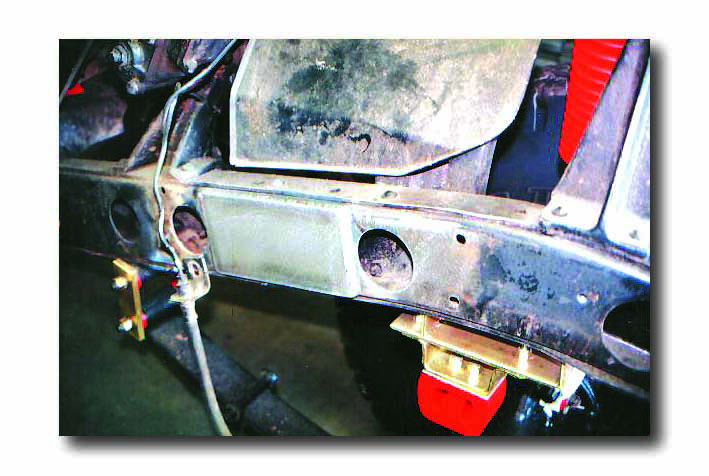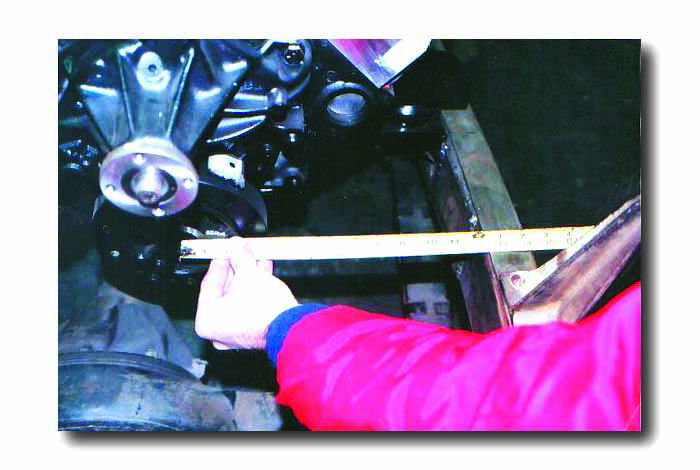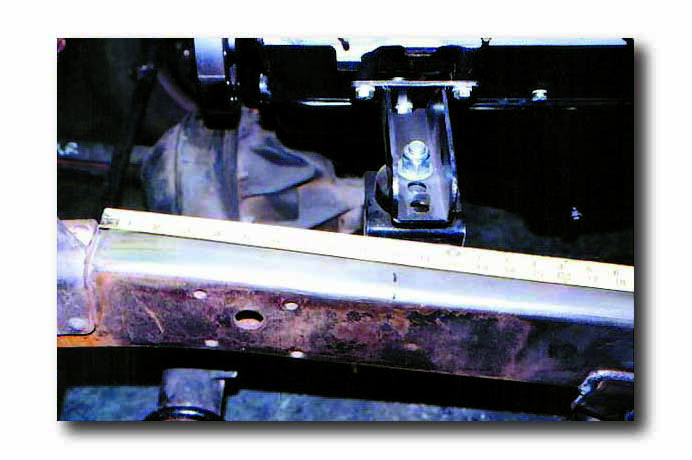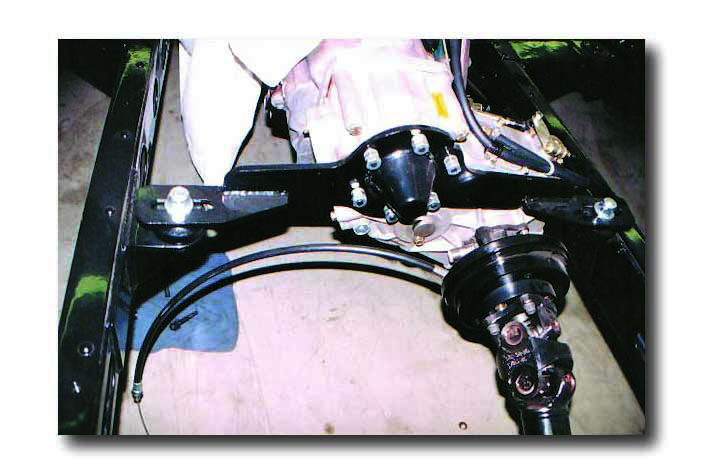Once the selection of your engine has been made, there are now a number of items that you must consider. The information listed in this section will cover most of your conversion considerations.
MOTOR MOUNTS: Your next requirement will be to purchase the proper engine mounts. The motor mounts we offer are for the Chevy V6/V8 and Ford V8. The V6/V8 mounts are a complete frame-to-block mounting system that uses a dual rubber donut design fastened together with a hardened bolt. This combination offers a positive means of securing the engine for the most severe offroad conditions.
Our universal motor mounts can be adjusted to accommodate the best possible engine location. Our universal Chevy and Ford side mounts are your best choice for Land Cruisers. The universal mounts are designed to be welded into position. When you position your engine (with the weld-in mounts), you must take into consideration such things as oil pan, steering box, and firewall clearances. Our Chevy V6/V8 mounts include new scab plates that should be welded to the inner frame rails. This will allow a better weld for the engine support bracket to the frame. On Ford V8 universal mounts mounts, the frame enclosures can be ordered under 713124-PLT.

Our engine mounts are provided with a slot for locating the engine assembly between the frame support bracket. The slots on the engine mount will allow your engine placement to be lined up in the desired location.
713124 - Chevy V6/V8 motor mounts
713002 - Ford V8 motor mounts
713088-TLC - Chevy LS1 & Vortec Gen. III motor mounts
ENGINE LOCATION: Depending on your engine selection and transmission type, you will find that the Toyota Land Cruiser chassis has ample room. We have established some guidelines for the most popular conversions, but due to the various combinations we suggest that you consider all of the options before final drivetrain location is established. Keep in mind that the original driveshaft length can be maintained - provided the transfer case is kept in the original location. Many times customers will sacrifice engine location to eliminate driveshaft modifications. We highly recommend that you position the engine in a location similar to the measurements to follow. Driveline modifications are cheaper in the long run than improper engine placement.
The correct engine location on a FJ40 is easily determined by measuring from the rear edge of the shock tower. The placement of the “L” bracket will vary because there are several drivetrain combinations. An ideal location for the “L” bracket is between 8” to 12” from the rear of the stock tower to the center of the “L” bracket. When placing the engine between the frame rails, it should be offset 1/2” to 1” (depending on which transmission is being used) toward the driver’s side to allow for proper front driveshaft clearance. When positioning the engine, the height of the “L” bracket should be either flush and/or up to 1/2” above the frame rail. This varies due to the lateral location of the “L” brackets. Ideally, the engine should have a 3 to 5 degree tilt towards the rear once the engine and transmission are installed. NOTE: These are only guidelines to assist you. Not all engine conversions are the same.



When retaining the stock 4 speed, driveline modifications are normally required. It is critical not to place the engine too far forward since this will cause problems with the 4 speed shifter handle location and the heater vent. One way to alleviate these problems is to utilize the Mark’s 4WD bellhousing adapter or the Ranger Torque Splitter. Either one of these options can result in eliminating driveshaft modifications as well as other clearance problems. Using either one of these options will allow you to leave the 4 speed in the stock location and build forward, thus allowing the engine placement to be determined.
On 3 speed conversions, the same rules apply with regard to the Mark’s adapter or Ranger Torque Splitter. The 3 speed can also be retained by reversing the front and rear drivelines and then locating the engine placement accordingly. However, you will have floorboard modifications, and the engine placement may not always be in the ideal location.
When converting to a new engine and transmission, it is impossible for us to determine whether or not driveline modifications will be required on your application. By using the engine placement suggestions, place the engine in a location that best suits your needs. As a reminder, driveline modifications will sometimes simplify a conversion verses an incorrect engine placement, which could cause other problems and expenses. Whatever engine is being installed (Ford or Chevy V8), we highly recommend that the frame rails have a scab plate welded into position. This material is 1/8" thick flat steel and should be positioned directly between the frame rail and our support mount. To make sure that you select and position your Land Cruiser drivetrain in a suitable location, you should consider the following: Radiator Clearance Oil Filter Accessibility Transmission Adapter Steering Box Clearance Exhaust System Allowance Transmission Shifter Location Transfer Case Shifter Location Hood Clearance for Air Cleaner Firewall Clearance for Distributor Front Axle Clearance for Balancer Driveshaft Angles for Starter Motor Optional Ranger 2 Speed Installation Optional Saginaw Steering Conversions Optional Headers for Strg. Box Clearance Heater Clearance around Transmission Shifter
DISTRIBUTOR CLEARANCE: A V8 engine fits well into the Land Cruiser engine compartment. Most applications do not require any firewall modifications. When positioning the engine in the most rearward location and using a large H.E.I. distributor cap, firewall modifications may be required on this type of Chevy application.
BATTERY LOCATION: The battery mounting plate and support will need to be relocated behind the passenger side headlight or the passenger side firewall if the heater is not going to be used. The stock battery tray can be used, or some companies offer an aftermarket battery mounting tray that could be used as an alternative.
RADIATOR: Most applications can retain the stock radiator for cooling the new V8 engine; however, for the ultimate cooling option we offer our own band of aluminum Rad-A-Kool radiators. Our 2 core radiator can be ordered with or without a transmission cooler (P/N 716697-AA for automatics or P/N 716697-AB for manuals). These radiators fit the 1960 to 1983 FJ40 and FJ45 Land Cruisers. The radiators measure 20-1/2” tall, 20-1/4 wide, and 3” thick. NOTE: These radiators will not fit later model FJ40s with factory air conditioning. Please specify if your vehicle was equipped with factory air conditioning. A special radiator measuring 19” tall, 22-1/2” wide, and 3” thick can be ordered to fit your application at no additional charge. Aluminum Radiator Features: *1” wide core tubes *No Epoxies,100% TIG Welded *Air Pressure Tested *18 Fins per inch *Temperature Sensor Provision *.083” Mounting Flanges *Billet Filler Neck *Cross Flow Design *LT1 or LS1/Vortec order option Our billet filler neck requires a standard GM overflow system style cap (3/4" depth). We recommend a 22 lbs. cap pressure. A higher pressure cap increases the boiling point. A higher pressure cap keeps the fluid in the cooling system, not the recovery tank. We offer a new 22 lbs. radiator pressure cap. This cap, PN716679, fits our Aluminum radiators. Our Toyota radiator can be ordered with or without a transmission cooler. The radiator has two 1/4" NPT fittings welded into the tank. We also include two 1/4” Male NPT x 5/16” inverted flare fittings. A benefit of the transmission cooler in the radiator is the heat exchange between the radiator and the tranny cooler. The radiator brings the transmission fluid up to a safe and constant operating temperature.
Our radiators are designed to fit standard GM engines. Newer blocks such as the LT1, LS1, and Vortec Gen. III blocks will require some additional features to be added to the radiator. A steam return option and smaller water inlets and outlets must be incorporated to our radiator when using it to a newer block. When ordering, please add LT1 to our part number when using a LT1 block, and add LS1 to our part number when using a LS1 or Vortec Gen. III block.
When using the stock Land Cruiser radiator in a Chevy application, a lower hose from a 1973 V8 Chevy pickup can be used. For the upper hose, DAYCO P/N 70858 or Napa P/N 7672 works well. The thermostat housing must be a straight design. For a Ford engine swap, a trip to your local auto parts store will be necessary since we do not have any suggestions for these applications.
FANS: On most conversions, you will be able to use a stock engine-driven fan. Most custom Land Cruiser aftermarket companies offer fan shrouds that work well with the engine-driven fan. We have seen a few engine-driven clutch fans that are too large in diameter to allow access for the radiator hoses. These can be switched out for either a flex fan or electric fan. Electric fans have become a popular addition to aid in cooling most engine swaps. Electric fans can be positioned in front or behind the radiator and offer efficient engine cooling.
The Spal fans we offer are the high performance straight bladed pusher or puller fans. These 16” fans are 16.3” tall, 15.75” wide, and 3.39” deep at the fan’s motor. The fans are rated at 2360 CFM and, being that they are pre-shrouded, they are ideal for cooling larger engines. The only down side of these fans is the noise they generate that can be heard from the driver’s seat (worse on a pusher than a puller). Our fan kits come complete with the needed wiring harness which is compatible with both positive and negative ground vehicles. The 3/8” pipe thread sending unit is designed to turn the fan on at 185 degrees and off at 170 degrees. The kit comes with a 40 amp relay, a fuse holder, and all other necessary hardware. In addition, our kit also includes mounting brackets for the fan to the radiator. The mounting brackets are designed for our aluminum radiators, however; we can supply you with brackets to fit our copper/brass radiators upon request. 716670 is our puller fan kit and 716671 is our pusher fan kit.
WATER TEMPERATURE BUSHING: When installing a Chevy engine, 716023 will allow you to retain your stock sending unit. With this bushing you can reinstall the original Land Cruiser temperature probe back into the intake manifold or head of most Chevy blocks. This special bushing has a metric female thread for use with the original probe. The outside diameter of this bushing is 1/2” with a pipe thread. Ford engines, Chevy LT1, LT4, LS1, Vortec engines have a smaller diameter hole in the block for the sending unit. These blocks will require the bushing 716023-LS sensor adapters. We also offer in-line adapters that fit on the radiator hose and allows you to retain your vehicle stock temperature sending unit and stock gauge. These units are offered in either 1-3/8” or 1-1/2” hose diameter. 716673A - 1-3/8” with 1/2” sensor hole. 716674 - 1-1/2” with 1/2” sensor hole.
WATER PUMPS & THERMOSTATS: We offer a high performance line of water pumps that will aid in V8 cooling. Chevy engine installations have the option of either a long or short water pump. The long style water pump is most commonly used on Chevy blocks. The stock bracketry on most V6 & V8s is designed to be used with a long style water pump. A short water pump will give additional radiator clearance; however, accessory brackets are sometimes hard to come by. We offer a high performance brand of water pumps and thermostats for Chevy V6 & V8 conversions.
Chevy & Ford blocks can usually retain a stock serpentine belt system. They will normally provide sufficient clearance for your radiator. Be careful if you replace the water pump on a Serpentine system since they usually rotate in the opposite direction.
FLOWKOOLER Pumps:
25-1668 - GM short water pump (1955-91 Chevy). This water pump is 5-11/16” long. (GM short water pump has limited accessory mounting bracket options)
25-1759 - GM long water pump (1955-91 Chevy). This water pump is 6-15/16” long. FLOWKOOLER Thermostat:
25-1600 - 160 degree high flow thermostat (All brass and copper construction with a “balanced sleeve”)
EXHAUST HEADERS / STOCK MANIFOLDS: On most conversions, you will have the option of using a custom exhaust header or stock manifold. If headers are to be used, you will need to verify your State’s emission requirements since the headers we supply are not smog legal. The Chevy headers are offered in a “inside-the-frame rail” design. Due to vehicle variations, some modifications may be required when using our exhaust header systems.
Our headers are designed around conversions using our motor mounts. These headers are available in a non-plated finish. Chevy V8 headers
717011 - Ram horn style Chevy V8 headers
717015 - Ram horn style Chevy V8 (std port head w/ angle plugs)
717016 - Ram horn style Chevy V8 (D-port head w/ angle plugs)
717043 - Gen III center dump headers.
For smog legal conversions, stock manifolds will be required. For Chevy applications, most late model manifolds are a rear dump. Fitting these rear dump manifolds into a Land Cruiser can sometimes be a tight fit when using the original Land Cruiser steering box. You will find that the clearance between the two will be very limited. When selecting stock manifolds, we suggest a Chevy passenger car-style which will allow a bit more clearance. If you are not required to be smog legal but wish to use a stock manifold, we recommend the use of the Centerdump or Rams horn style (GM Rams Horn centerdump manifold #372243). Select manifolds that have alternator mounting bracket holes.
On Ford applications, the exhaust manifolds off a Mustang or Explorer V8 should provide ample clearance for the stock steering and frame rails. Smog exempt vehicles could use manifolds off of an early Maverick or Comet. These manifolds, however, are rear dump and can cause some clearance problems with the stock Land Cruiser steering box.
OIL PRESSURE GAUGE: The original oil pressure gauge can be retained and the sending unit reinstalled back onto the new engine. On Chevy V8 conversions, you will need to use a 1/8" NPT x 1-1/2" pipe nipple and a 45 degree elbow for installation behind the V8 distributor. Use a thread sealant tape to compensate for the metric thread installation into the 1/8" pipe size.
EMERGENCY BRAKE: Some Land Cruisers are equipped with an emergency brake drum on the back side of the transfer case. When installing a V8 engine with the original transmission, the drivetrain will either remain in the same location or extend forward. Modifications to the brake cable in either case will not be required. On conversions using a longer transmission combination than stock (such as an automatic), you will be required to reroute this cable, and/or possibly extend it.
SPEEDOMETER CABLES: The speedometer is connected to the backside of the transfer case. When installing a V8 engine with the original transmission, the drivetrain will either remain in the same location or extend forward. On conversions using a longer transmission combination than stock (such as an automatic), you may be required to reroute the speedometer cable. If the cable is still too short, we offer a 12” extended cable, 716186-C.
THROTTLE REQUIREMENTS: Your stock throttle pedal can easily be connected to a universal cable linkage. We offer a few custom cable linkages to aid in this connection. These cut-to-fit assemblies work great with most conversions.
23-0010 - 24” SS Hi-Tech throttle cable
23-0012 - Tuned Port SS throttle cable
23-0011 - 24” Universal black throttle cable
23-0015 - Stainless Steel carburetor bracket.
23-0013 This new adjustable pedal can be offset to either side of the pivot mount.
STEERING: The early model Land Cruisers were equipped with a steering gear box that was located at the base of the steering column. The stock Land Cruiser steering system often had excessive play and backlash. You have the option of utilizing your stock steering or upgrading to a Saginaw steering system. The Saginaw system is a proven advantage for these vehicles. Both manual and power steering kits are available. For more information, refer to the Saginaw Steering section in this manual.
CROSSMEMBERS: Land Cruisers (1963 to August 1980) supported the stock transmission & transfer case by using a set of bellhousing mounts. Most engine conversions will require the removal of these stock bellhousing mounts. To properly support the drivetrain, a new crossmember is normally required. We offer two types of crossmember designs.
Transfer case crossmember: This popular design bolts on the back of the stock transfer case. For most conversions, crossmember 716022 works well. This crossmember replaces the 6 bolt cover on the rear of your stock transfer case. By removing the stock cover, our new crossmember bolts in its place. This crossmember kit comes with a gasket and 6 stud bolts. These new studs will provide a much stronger connection between the new crossmember and the back of the transfer case. The crossmember support has a special welded cup that allows for clearance of the transfer case output shaft. Position the crossmember onto the back of the transfer case and secure it using the nuts provided. This crossmember extends outward to each frame rail. It is supported by “L” brackets that must be welded to the frame rail (similar to the motor mount installation). The frame rails should be scabbed-in using the scab plates provided with the kit. These components are insulated on rubber cushions. This crossmember is recommended with all transfer case adapters except when using a TH350, 700R & TH400.

FJ55 & longer tranny assemblies: On FJ55 wagons and longer transmission assemblies such as the TH400 or NV4500, you will need to use a different crossmember assembly, 716022-TSW. The frame rails start to taper outward, so it is necessary that you have longer frame brackets on these particular applications. TH350, 700R & TH400 automatics: When installing an automatic transmission to your transfer case, we recommend the use of a new crossmember, 716004, underneath the adapter housing. All of the Advance Adapter tailhousings have two tapped holes for this standard rubber support. This provides an excellent support, although it does take away some of the ground clearance necessary for 4-wheeling. This crossmember kit comes complete with frame brackets and the crossmember support mount necessary for the adapter connection. The crossmember for the TH350 & 700R bolts to the bottom of the adapter housing using a stock GM rubber mount. This tubular crossmember extends to the inner frame rails. It is supported by “L” brackets that must be welded to the frame rail.
1981-1990: Vehicles with the split-style 19 spline transfer case used a crossmember that was located underneath the stock transmission. Some of our transfer case adapters will allow you to retain this stock crossmember; however, it will need to be relocated on the frame rails. Some of our other transfer case adapters for applications like the NV4500 & TH400 require you to fabricate a new crossmember.
A conversion crossmember for the FJ60 and FJ62 Land Cruisers is also available. Although the adapter for the GM 700R or 4L60E transmission allows you to retain the stock rubber crossmember mount, it still requires you to modify it to fit the stock crossmember to fit the transmission mount in the new location in the frame rails. The new crossmember mount, 716183, is a weld-in kit that will increase your ground clearance. This mount reuses the factory rubber mount and is adjustable to fit the frame rails with the newly installed transmission.
FJ60 retaining the 4 speed: On FJ60 engine conversions retaining the original 4 speed transmission, you will need to keep the original transmission support that runs directly underneath the 4 speed transmission. To alleviate the relocation of this stock crossmember, we highly recommend the use of the Mark’s 4WD adapter or the Ranger Torque Splitter. Both these applications will allow you to retain your stock 4 speed and crossmember in its original location.
FJ60 with stock automatic: On FJ60 engine conversions retaining the original automatic transmission, you will retain the original transmission support that runs directly underneath the stock adapter housing. On vehicles replacing this automatic (depending on the transmission application you chose), you may need to fabricate a new crossmember to fit your transmission choice.
FJ62, FJ80, FZJ80, and 100 Series with stock automatic: On all of these engine conversions retaining the original automatic transmission, you will retain the original transmission support that runs directly underneath the stock adapter housing. On vehicles replacing this automatic (depending on the transmission application you chose), you may need to fabricate a new crossmember to fit your transmission choice.
SUSPENSION & BODY LIFT: No major suspension modifications are required when installing a new V8 engine. A Chevy or Ford V8 is approximately 250 lbs. less than a stock 2F engine. A Chevy or Ford V8 engine can normally be installed without your vehicle having a body lift; however, body lifts on any Land Cruiser conversion will provide additional drivetrain clearance. Chevy 292 in-line 6 cylinder engine conversions retaining the stock 3 speed will require a 1” body lift for bellhousing clearance.
ELECTRICAL SYSTEM: If using a “points” type distributor, you will need to install the GM coil and resister (listed below) and wire as illustrated. GM Coil GM# 1115202 GM External Resistor GM# 1957145
When using an “H.E.I.” pointless distributor, you will need to couple the wire that was originally attached to the positive side of your stock coil directly to the “H.E.I.” distributor. This wire attaches to the ignition post on your ignition switch. It is routed through a 15 amp fuse at the stock fuse holder panel and then to the positive side of the stock coil.
For computer controlled blocks, we recommend that you purchase a wiring schematic from your local dealer that identifies the correct color codes of the wires. When doing in-house conversions using the later model blocks, we have found it easier to purchase a custom wiring harness from the following companies: Howell Engineering (810) 765-5100 (GM harnesses) BTB Products (702) 568-1511 (GM Vortec harnesses) Street & Performance (501) 394-5711 (GM & Ford harnesses) QITLC40
STOCK AUTOMATIC TRANSMISSION (A440F & A440L) ELECTRICAL SYSTEM REQUIREMENTS: This transmission is electronically shifted. For this transmission to operate properly when coupled to a GM engine, it will require two readings. The first is a reading from the tachometer and the second is a throttle position sensor. The throttle position sensor from the Land Cruiser engine must be fabricated to fit onto the new GM engine. The tachometer reading can be obtained by the tachometer interface kit offered by Mark’s 4WD.
TACHOMETER INTERFACE: Dakota Digital # SGI-8E.